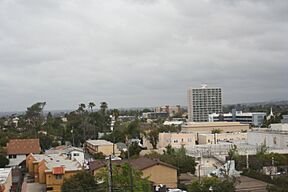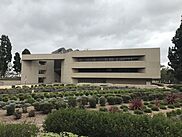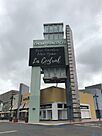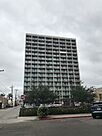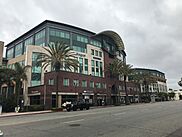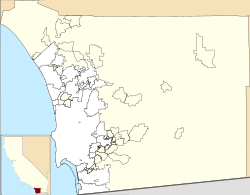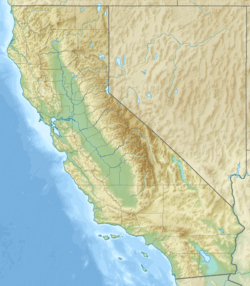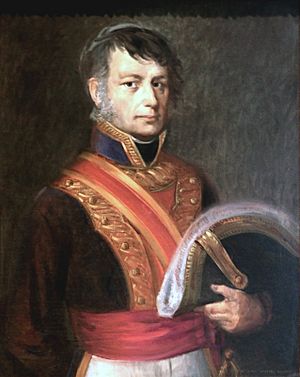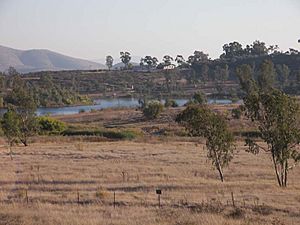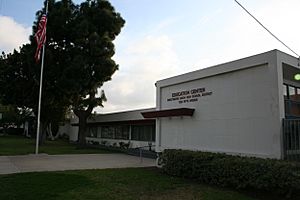Chula Vista, California facts for kids
Quick facts for kids
Chula Vista, California
|
|||
|---|---|---|---|
|
From top to bottom, left to right: Downtown Chula Vista, South County Courthouse, Chula Vista Center, Congregational Tower, Gateway Buildings.
|
|||
|
|||
| Nicknames:
Lemon Capital of the World
|
|||
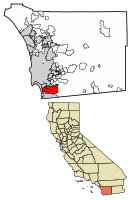 |
|||
| Country | |||
| State | |||
| County | |||
| Incorporated | November 28, 1911 | ||
| Named for | Spanish for "beautiful view" | ||
| Government | |||
| • Type | Council-Manager | ||
| Area | |||
| • City | 52.09 sq mi (134.92 km2) | ||
| • Land | 49.64 sq mi (128.56 km2) | ||
| • Water | 2.46 sq mi (6.36 km2) 4.73% | ||
| Elevation | 66 ft (20 m) | ||
| Population
(2020)
|
|||
| • City | 275,487 | ||
| • Rank | 2nd in San Diego County 15th in California 82nd in the United States |
||
| • Density | 5,549.70/sq mi (2,142.87/km2) | ||
| • Metro | San Diego–Tijuana: 5,105,768 | ||
| Time zone | UTC−8 (PST) | ||
| • Summer (DST) | UTC−7 (PDT) | ||
| ZIP codes |
91909–91915, 91921
|
||
| Area code(s) | 619 | ||
| FIPS code | 06-13392 | ||
| GNIS feature IDs | 1660481, 2409461 | ||
Chula Vista is a city in San Diego County, California. Its name means "beautiful view" in Spanish. This name fits perfectly because the city is located between San Diego Bay and coastal mountains.
It is the second-largest city in the San Diego area. Chula Vista is also the 15th largest city in California. In 2020, about 275,487 people lived there. The city is located in the South Bay. It is about 7.5 miles (12 km) from downtown San Diego.
Before the Spanish arrived, the Kumeyaay people lived here. In 1821, the area became part of Mexico. California joined the United States in 1848. Chula Vista was officially started in the early 19th century. It became a city in November 1911.
Today, Chula Vista is home to the Chula Vista Elite Athlete Training Center. It also has Sesame Place San Diego, North Island Credit Union Amphitheatre, and the Living Coast Discovery Center.
Contents
History of Chula Vista
Early Beginnings
Long ago, fossils of sea creatures were found in Chula Vista. Human activity in the area dates back about 10,000 years. The Kumeyaay tribe lived on this land for hundreds of years. They had a village called Chiap near the bay.
In 1542, Spanish ships sailed into San Diego Harbor. This led to Spain claiming the land. The Kumeyaay village of Chiap became a center of a revolt against the Spanish in 1775. The land later became known as Rancho de la Nación.
After Mexico became independent from Spain, Chula Vista was part of Alta California. In 1829, the land was divided into large ranches. These ranches were owned by important families.
In 1873, the United States Army built a telegraph line through Chula Vista. This line connected San Diego to Fort Yuma.
The Lemon Capital
The San Diego Land and Town Company helped develop the land for new settlements. The first house was built in 1887. By 1889, ten houses were finished. Around this time, lemons were brought to the city. The name Chula Vista, meaning "beautiful view," was suggested by a dam designer.
The Sweetwater Dam was finished in 1888. This allowed farmers to water their crops. Chula Vista became the biggest lemon-growing area in the world for a while. Some of the oldest buildings in the city are from this time. In 1889, the first watch factory west of the Mississippi River opened here. Railroads were also built through the city.
Growing in the 20th Century
By 1911, Chula Vista had 15,000 acres (61 km²) of farmland. About 4,000 acres (16 km²) were lemon groves. The citizens voted to become a city on October 17, 1911. A Carnegie Library was built in 1915. In the 1910s, many Chinese, Filipino, and Mexican farm workers came to the city.
In 1916, a big flood called the Hatfield Flood hit Chula Vista. The Lower Otay Dam broke, flooding the valley. Later that year, the Hercules Powder Company opened a factory. It made materials for gun propellants used in World War I. In 1925, the first aviation school opened in Chula Vista.
The Great Depression affected Chula Vista, but farming still brought in money. In the 1930s, Japanese American farms helped grow new crops like celery. Filipino and Mexican farm workers even went on strike for better conditions.
In 1941, the Rohr Aircraft Corporation moved to Chula Vista. This changed the city from farmland to a factory town. During World War II, 11,000 employees at Rohr made parts for airplanes.
During World War II, Japanese Americans living in Chula Vista were forced to move to special camps. This happened because of a government order. One person, Joseph K. Sano, was a veteran who was sent to a camp. His family's land case, Oyama v. California, even went to the U.S. Supreme Court.
After World War II, Chula Vista grew very fast. Its population tripled from 5,000 in 1940 to over 16,000 in 1950. Many factory workers and soldiers stayed in the area. The city expanded, and the last farms disappeared. By the 1960s, more Filipinos and Mexicans moved to Chula Vista. In 1963, it became the second-largest city in San Diego County.
In 1985, Chula Vista made the biggest land addition in California history. This included the areas of Castle Park and Otay. The city continued to grow eastward. New neighborhoods like Eastlake, Rancho del Rey, and Otay Ranch were planned. In 1995, the United States Olympic Committee opened an Olympic Training Center in Eastlake. It was built on land that was given to them.
Chula Vista in the 21st Century
By 2003, Chula Vista had 200,000 residents. It was one of the fastest-growing cities in the nation. Thousands of new homes were built in areas like Otay Ranch and Eastlake. The South Bay Expressway, a toll road, opened in 2007.
Many people from Tijuana, Mexico, moved to Chula Vista. This was due to safety concerns in their home city. In 2017, Chula Vista bought the Olympic Training Center. It was renamed the Elite Athlete Training Center. The U.S. Olympic Committee still uses it and pays rent to the city.
In 2019, Chula Vista became the first city in California to be called a "sanctuary city" by a non-profit group. However, this title was later removed in 2022. This happened because the Chula Vista Police Department was sharing license plate data with federal agencies.
Geography
Chula Vista is located in the South Bay area of San Diego County. It sits between the Jamul Mountains and San Diego Bay. The city's name, "beautiful view," truly describes its location.
Chula Vista is the second-largest city in San Diego County by area. It covers about 52.1 square miles (134.9 km²). Most of this area is land, with a small part being water.
Natural Areas
Chula Vista has important natural spaces. It includes the Sweetwater Marsh unit of the San Diego Bay National Wildlife Refuge. The city also has its own open space areas. These places help protect local wildlife and nature.
Neighborhoods
Chula Vista has two main parts: West Chula Vista and East Chula Vista.
West Chula Vista
This is the older part of the city. It includes the original Chula Vista area. The community of Montgomery was added to the city in 1986. West Chula Vista does not have special fees called Mello-Roos. This is different from the eastern part of the city.
East Chula Vista
Starting in the late 1980s, new planned communities were built here. These include Eastlake, Otay Ranch, and Rancho del Rey. These areas are east of Interstate 805.
"Eastlake" is often used to describe a larger area. This is because many businesses use the name. It can be confusing because the real Eastlake is built around a small pond. The much larger Lower Otay Reservoir is sometimes mistaken for it.
Many families from Tijuana, Mexico, have moved to East Chula Vista. This area has become a popular place for them to live. In 2018, a new bus route was created. It connects the Otay Mesa border crossing to eastern Chula Vista and downtown San Diego.
Climate
Chula Vista has a mild climate. It is often sunny and warm. The average temperatures do not change much throughout the year.
The highest temperature ever recorded was 103°F (39°C). The lowest was 24°F (-4°C). Summer nights are warm, but not too hot. The city gets some rain, mostly in the winter months.
Population and People
Chula Vista has grown a lot over the years. In 1920, only 1,718 people lived there. By 2020, the population was 275,487.
The city is very diverse. In 2022, about 64.9% of the people were Hispanic or Latino. Other large groups include White, Asian, and Black or African American residents. Many people in Chula Vista have family roots from different parts of the world.
The average household size in Chula Vista is about 3.25 people. Many households have children under 18. The median age in the city is about 35.9 years old.
Economy
Chula Vista has a strong business environment. Small businesses are a big part of the city's economy. They help the city grow and create jobs.
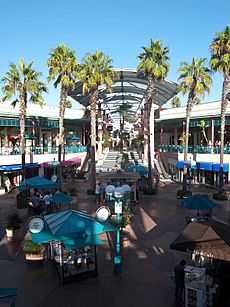
In 2001, a Japanese printing company chose to open an office in Chula Vista. They picked the city because of its diverse population. There were already many Japanese businesses and services there.
Fun Things to Do
Tourism is important for Chula Vista's economy. The city has many places to eat, shop, and watch movies. There are also several golf courses.
Some popular attractions include:
- The Living Coast Discovery Center: This center has exhibits about the local bay and marsh. You can see sharks, rays, birds, and learn about nature.
- Otay Valley Regional Park: A large park with a natural river valley.
- North Island Credit Union Amphitheatre: A big outdoor concert venue.
- OnStage Playhouse: The only live theater in the South Bay, San Diego.
- Chula Vista Marina: A place for boats and water activities.
- Sesame Place San Diego: A theme park based on the TV show Sesame Street.
- Chula Vista Elite Athlete Training Center: Where top athletes train for sports like archery, rowing, soccer, and cycling.
Chula Vista Center is the city's main shopping mall. It opened in 1962.
Major Employers
Many people in Chula Vista work for schools and hospitals. Here are some of the top employers:
- Sweetwater Union High School District
- Chula Vista Elementary School District
- Sharp Chula Vista Medical Center
- Southwestern College
- Walmart
- City of Chula Vista
- Rohr Inc./Goodrich Aerospace
- Scripps Mercy Hospital Chula Vista
- SBCS Corporation
- Costco
Arts and Culture
Chula Vista has a lively arts scene. OnStage Playhouse offers live theater shows.
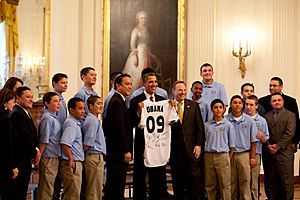
Downtown Chula Vista hosts many fun events. These include the famous Lemon Festival, the Starlight Parade, and the Chula Vista Rose Festival. The North Island Credit Union Amphitheater brings big concerts to the area.
Sports
Chula Vista is a great place for sports. It is home to the Chula Vista Elite Athlete Training Center. This is where the U.S. national rugby team practices.
The city also has successful youth sports teams. In 2009, Parkview Little League won the 2009 Little League World Series. They were nicknamed "The Blue Bombers." In 2013, Eastlake Little League won the American Championship at the 2013 Little League World Series.
In 2018, Rebels SC soccer club started the city's first United Premier Soccer League team.
Education
Most students in Chula Vista attend schools in the Chula Vista Elementary School District. This is the largest elementary school district in California. For middle and high school, students go to schools in the Sweetwater Union High School District.
Chula Vista also has colleges. Southwestern College is a community college. It serves about 19,000 students each year. Chula Vista Christian University (CVCU) is a private university that opened in 2020. The city has been trying to get a four-year university built since 1986.
Transportation
Major Roads
Chula Vista has several important highways. Interstate 5 runs along the western side of the city. It connects Chula Vista to other parts of San Diego County and Los Angeles. Interstate 805 is another major highway that bypasses Interstate 5. Interstate 905 goes from the Otay Mesa border crossing. State Route 54 and State Route 125 connect the city to eastern areas.
Sister Cities
Chula Vista has two sister cities. These are cities in other countries that have a special friendship with Chula Vista.
| City | Province/State/Prefecture | Country |
|---|---|---|
| Irapuato | Guanajuato | Mexico |
| Odawara | Kanagawa | Japan |
Images for kids
See also
 In Spanish: Chula Vista para niños
In Spanish: Chula Vista para niños


